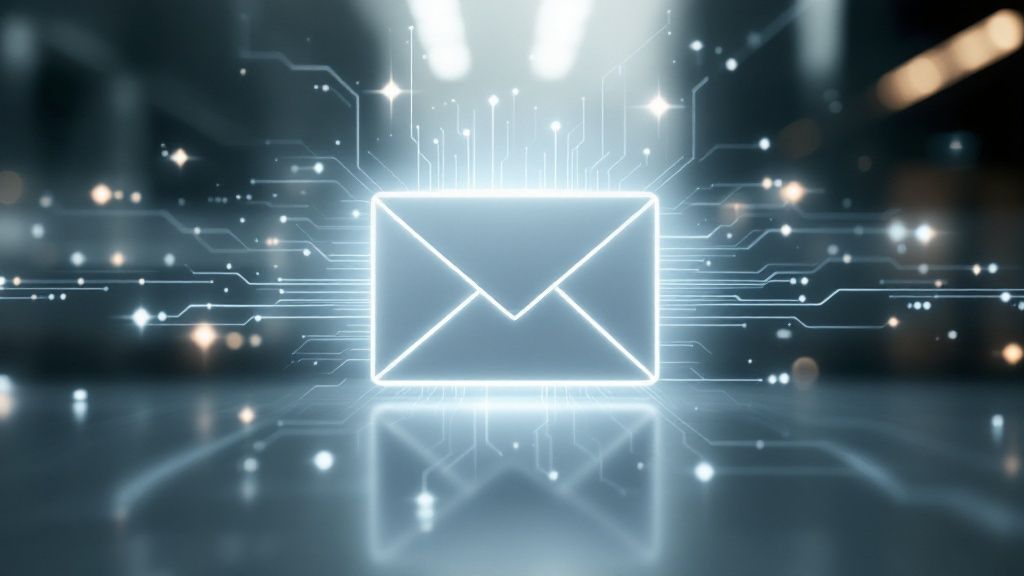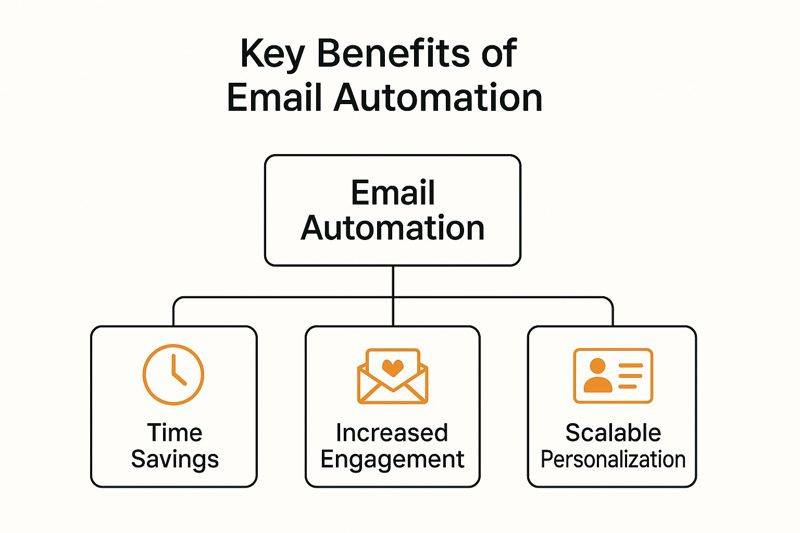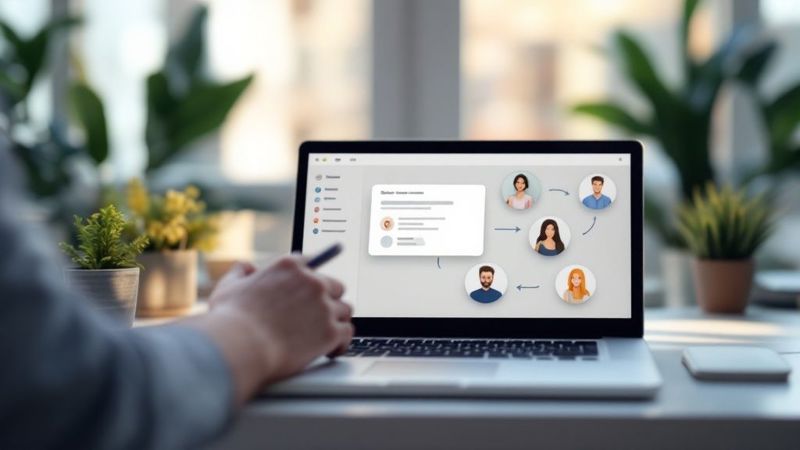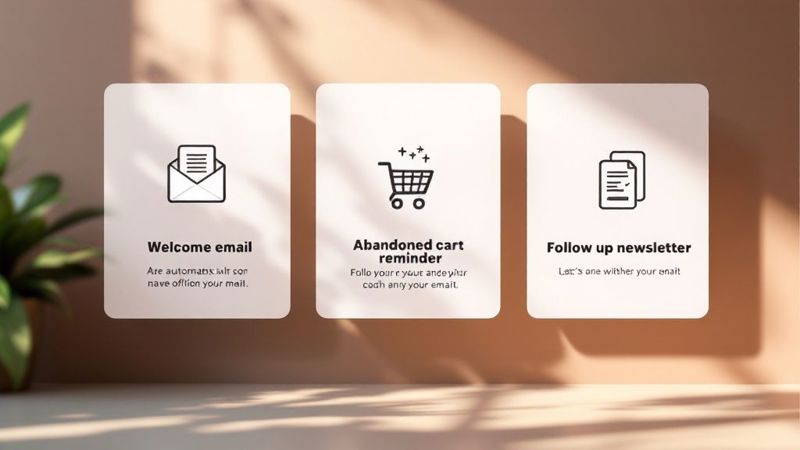Ever wondered how some companies seem to send the perfect email at the exact right moment? Chances are, they’re not sitting there hitting "send" 24/7. They're using email automation.
At its core, email automation is all about sending pre-written emails to subscribers automatically based on specific triggers or timelines. It’s like having a smart assistant who works around the clock to deliver personal, relevant messages without you lifting a finger.
Understanding Email Automation
Think of it this way: instead of shouting one generic message to your entire list with a standard newsletter, automation lets you have thousands of individual, one-to-one conversations at scale. It’s a system designed to react to what your customers actually do.
This shift from broadcasting to conversing is a fundamental one. It’s the difference between sending a generic flyer and having a helpful salesperson guide a customer through your store. We dive deeper into this concept in our guide on how to send mass email individually.
To help clarify the difference, let’s look at a quick comparison.
Manual Email Vs Automated Email At A Glance
This table breaks down the key distinctions between the traditional "email blast" and a modern, automated approach.
| Aspect | Manual Email Marketing | Automated Email Marketing |
|---|---|---|
| Timing | Sent at a scheduled time to everyone. | Sent when an individual takes an action. |
| Message | One-size-fits-all, generic content. | Highly personalized and relevant. |
| Scale | Labor-intensive; difficult to manage. | Scalable; runs continuously in the background. |
| Purpose | Broad announcements (e.g., newsletters). | Nurturing leads, recovering carts, onboarding. |
As you can see, automation isn't just about scheduling—it's about responding.
Triggers and Workflows: The Heart of Automation
The real magic behind email automation comes down to two simple but powerful components: triggers and workflows.
- Triggers: These are the specific events that kick off an automated email sequence. A trigger could be anything—a new user signing up, someone visiting a specific product page, or even a customer abandoning their shopping cart.
- Workflows: This is the pre-defined journey you map out for your subscribers once a trigger occurs. It’s a set of rules that dictates which email gets sent, when it goes out, and what happens next based on how the user engages.
This diagram shows how it all fits together. A user's action (the trigger) sets off a pre-built sequence of emails (the workflow).

This shows that automation is a responsive system, not just a scheduling tool. It’s about building a relationship that evolves with each customer's actions.
And it works. The proof is in the numbers. A whopping 63% of marketers have adopted it, and the results speak for themselves. Automated emails can generate 70% higher open rates and an incredible 152% higher click-through rates compared to standard campaigns.
The Building Blocks Of Your Automation Engine
Every powerful email automation is built from just a few simple, interconnected parts working in harmony. Think of it like a recipe—you combine a few key ingredients in the right order to create something amazing. Once you get the hang of these core components, you'll see just what email automation can really do for your business.
At its core, you need a system to manage everything. This is where dedicated email marketing platforms like Mailchimp come in, giving you the toolbox to build and send these automated emails. With a platform in place, your focus shifts to the three main building blocks.
Triggers And Actions
The first ingredient is the trigger. A trigger is the specific event that kicks off an automated sequence. It’s the "if this happens" part of your automation recipe. Triggers can be almost anything a customer does (or doesn't do).
- Behavioral Triggers: A user abandons their shopping cart, clicks a link in a previous email, or views a specific product page three times.
- Transactional Triggers: A customer makes their first purchase or buys a specific product.
- Time-Based Triggers: It has been 30 days since a user last logged in, or it's a subscriber's birthday.
Following every trigger is an action. This is the "then do that" part of the equation—the task your system performs automatically. While the most common action is sending an email, it could also be something else, like adding a subscriber to a new list, updating their contact info, or assigning them a lead score.
By linking a specific action to a user's trigger, you move from generic broadcasting to highly relevant, one-on-one communication. This simple cause-and-effect relationship is the foundation of all effective automation.
Workflows The Complete Journey
Finally, workflows (sometimes called sequences or journeys) are the complete maps that connect your triggers and actions into a cohesive customer experience. A workflow defines the entire path, from the initial trigger to the final message, including any delays or conditions along the way.
This infographic shows the high-level benefits that well-designed workflows can bring to your business.

As you can see, combining these building blocks leads to major improvements in efficiency, customer engagement, and personalized marketing at scale.
How Automation Transforms Your Marketing

Putting in the time to build out automation workflows pays off in real, tangible ways that go far beyond just sending out emails. It’s about making your marketing smarter, more personal, and way more efficient.
At its heart, automation frees up your team from the tedious, repetitive tasks that eat up the day. This gives them back countless hours to focus on what really matters: big-picture strategy and creative thinking.
Instead of blasting out one-size-fits-all messages, you get to create a truly individual experience for every single customer. Imagine sending content that’s always relevant because it’s triggered by what they actually do—like browsing a specific product or downloading a guide. This is how you build genuine loyalty and trust, making subscribers feel understood rather than just another number on a list.
Boosting Revenue And Nurturing Leads
Building relationships is great, but what about the bottom line? This is where email automation really shines. Targeted workflows are designed to catch customers at just the right moment, turning potential losses into serious revenue.
The power of this targeted approach is staggering. While automated emails make up just a tiny fraction of sends, they can be responsible for nearly a third of all email-driven orders.
This impact is especially clear in e-commerce. Those cart abandonment reminders? They're the most popular automation for a reason—they work. Research from Hostinger on email marketing statistics shows that while automated emails account for a tiny 1.8% of all emails sent, they drive a massive 31% of all orders placed through email.
Why? Because 54.2% of these workflows focus on high-impact scenarios like abandoned carts.
Ultimately, automation is your best tool for consistently turning leads into paying customers. By delivering the right message at the right time—from a welcome series for new subscribers to a follow-up after a purchase—you create a seamless journey that guides people toward conversion. It just makes every bit of your marketing effort more profitable.
Powerful Automation Workflows You Can Build Today
Okay, theory is one thing, but seeing email automation in action is where the magic really happens. Let’s dive into some proven, high-impact workflows you can set up right now. These aren’t just busywork; they're designed to engage customers, build trust, and drive revenue—forming the backbone of a truly effective marketing strategy.
You don't need a super-complex system to get started. Most modern email marketing tools can handle these powerful sequences. Here are five essential campaigns you can build today.
1. The Welcome Series
If you only build one automation, make it this one. Your welcome series is your first, best chance to make a great impression. It's where you introduce your brand, set expectations, and connect with new subscribers right when they're most interested.
- Trigger: Someone subscribes to your newsletter or creates an account.
- Goal: To welcome, educate, and forge an immediate connection.
- Example Sequence:
- Email 1 (Immediate): Send a warm welcome and confirm their subscription. Simple.
- Email 2 (Day 2): Share your brand story or what makes you unique.
- Email 3 (Day 4): Point them toward your most popular products or best content.
2. The Abandoned Cart Reminder
For any e-commerce business, this workflow is a straight-up revenue saver. It automatically follows up with people who add items to their cart but bounce before checking out. It’s a gentle nudge to remind them what they left behind and bring them back to finish the order.
An effective abandoned cart sequence can recover a huge chunk of otherwise lost sales. It turns that moment of hesitation into a conversion just by giving a timely reminder.
3. The Lead Nurturing Sequence
Let's be real: not every lead is ready to buy the second they find you. A lead nurturing sequence is perfect for this. It educates potential customers over time, building trust and positioning your brand as the go-to expert for their problems. This is essential for service-based businesses or companies selling high-ticket items.
- Trigger: A user downloads a resource, like an ebook or webinar recording.
- Goal: Build trust, provide genuine value, and gently guide the lead toward a sale.
- Example: A series of emails offering more tips, sharing relevant case studies, and eventually, inviting them to schedule a demo or a consultation call.
4. The Re-Engagement Campaign
Over time, it's natural for some subscribers to go quiet. A re-engagement campaign (often called a "win-back" campaign) is designed to wake them up or, if that fails, clean up your email list.
- Trigger: A subscriber hasn't opened or clicked an email in 90 days.
- Goal: Either win back their attention or remove them to keep your list healthy and improve deliverability.
- Sequence: Try sending a "we miss you" email with a special offer or a quick poll asking what content they'd like to see.
5. Post-Purchase Follow-Up
The customer's journey doesn't stop at the checkout page. A post-purchase automation is all about building loyalty. You can follow up to thank the customer, ask for a review, or suggest related products they might love. It shows you value their business far beyond the initial sale and encourages them to come back for more.
How AI Is Making Email Automation Smarter

If you think of traditional automation as a smart assistant, then AI is its brain upgrade. We're moving beyond simple "if this, then that" rules. AI makes email marketing predictive, deeply personal, and a whole lot more effective by analyzing massive amounts of data to spot patterns humans would easily miss.
This isn't some far-off concept; it’s already happening. About 64% of marketers are using AI in their strategies right now. The results speak for themselves: AI-driven campaigns see a 13% jump in click-through rates and a 41% rise in revenue compared to standard automation. It's a massive shift.
Predictive Sending and Smarter Copy
One of the coolest things AI does is predictive send-time optimization. Instead of making an educated guess about the best time to send an email, AI looks at each user’s individual habits. It then delivers your message at the exact moment that person is most likely to open it. It's a tactic 66% of marketers using AI are taking advantage of.
AI doesn't just figure out when to send an email; it helps you figure out what to say. It can generate high-converting subject lines, polish your email copy, and even suggest the right tone for different audience segments.
This is a huge help for overcoming writer's block and making sure your message actually connects.
Enabling True Hyper Personalization
Beyond timing and copy, AI unlocks hyper-personalization on a level that manual segmentation just can't touch. It customizes content for every single recipient based on their unique behavior, making each email feel like a genuine one-on-one conversation.
This deep level of personalization is the core of effective email marketing automation best practices. If you want a solid primer on how AI fits into the bigger marketing picture, this Introduction to Artificial Intelligence in Digital Marketing is a great read. This shift turns automation from a simple tool into a true strategic partner.
Your Questions About Email Automation Answered
Diving into new tech always brings up a few questions. Let's clear the air and tackle some of the most common things people ask about email automation. The goal here is to give you clear, straight-up answers so you can feel confident moving forward.
Is Email Automation Only For Large Businesses?
Not a chance. Email automation scales beautifully for businesses of any size.
I've seen solo entrepreneurs use it to save precious time and stay in front of their customers, while bigger companies use it to build out incredibly detailed customer journeys. Most platforms offer affordable starting plans, letting you begin with a simple welcome series and add more as you grow. The efficiency and personal touch it adds are valuable for everyone.
The secret is to start small. You don't need some massive, complex system from day one. A simple, three-part welcome series can make a huge difference in engagement and build a solid foundation for more advanced workflows later on.
What Is The Difference Between Automation And A Newsletter?
Think of it as a conversation versus an announcement.
A newsletter is a one-to-many broadcast. You write it, and you send it to your entire list at a specific time, like a public announcement.
Email automation, on the other hand, is a one-to-one message sent automatically because an individual did something specific—like signing up, making a purchase, or clicking a link. Newsletters inform the crowd; automation reacts to the person. This personal approach is way more effective and often relies on a smart strategy for grouping your contacts, which is why understanding email segmentation best practices is so critical for success.
How Do I Get Started With Email Automation?
Getting started is probably easier than you think. You can boil it down to three initial steps:
- Pick a Tool: Choose an email marketing platform that has automation features built-in.
- Define One Goal: Decide on a single, clear objective for your first automation. Welcoming new subscribers is a perfect starting point.
- Map the Workflow: Sketch out the journey. What triggers it (someone subscribing)? What does the email say? When does it send?
Just start with one simple workflow, see how it performs, and build on it from there.
Ready to make every email feel personal? With OKZest, you can add unique, dynamically generated images to every automated email, boosting engagement and making your brand unforgettable. Start creating personalized images for free with OKZest today.